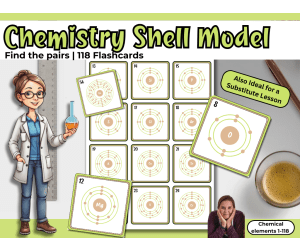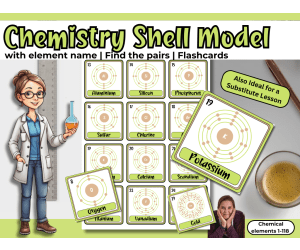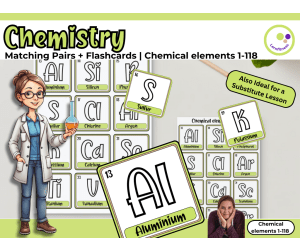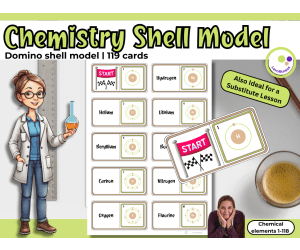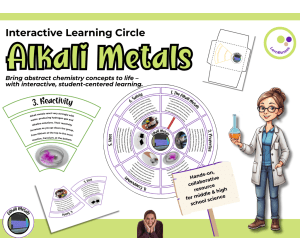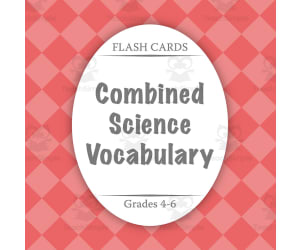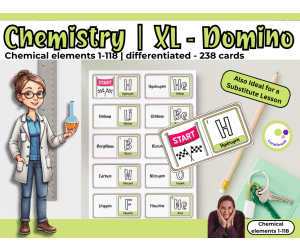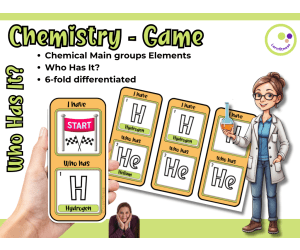2,743 products added recently
Chemistry Flashcards
Make chemistry concepts accessible with flashcards covering elements, compounds, reactions, and more. These visual aids help students grasp challenging topics. Incorporate them into your teaching to enhance comprehension in chemistry.
Shell Model – Chemistry Flashcards Without Element Names
STEM, Science, Chemistry, Physics, Life Sciences, Grade 7, 8, 9, 10, 11, 12, Activities, Games, Worksheets & Printables, Task Cards, Quizzes and Tests, Teacher Tools, Word Problems, Flashcards, Escape Room, Experiments
Shell Model – Chemistry Flashcards Without Element Names 118 cards for learning the periodic table Visual practice with atomic structure and electron configurations 🧪🔬 This printable flashcard set gives students a hands-on way to practice atomic structure and the shell model – without revealing the element names. Each of the 118 cards shows the atomic number, the chemical symbol, and a diagram of the electron distribution across shells. This encourages students to actively recall element names and deepen their understanding of how atomic structure relates to the periodic table. I’ve used these cards mainly for review and partner quizzes. Students really have to think: “What element has 11 electrons and that shell pattern?” or “Which group might this symbol belong to?” It shifts the focus from just memorizing the periodic table to actually understanding the structure behind it. What’s included: 118 printable flashcards (PDF) Each card includes: atomic number, symbol, and shell model (no element names) High-resolution layout, easy to print and cut Suggestions for classroom use included Classroom ideas: Use the cards as a “Find the Pairs” game: Print two sets and let students match identical cards or group elements by patterns. Use them for sorting tasks: metals vs. non-metals, main groups vs. transition metals, increasing number of shells, etc. Create mini-quiz stations: One student shows a card, the other has to guess the element name or describe properties based on the shell model. Let students use the cards to quiz themselves or work in pairs for peer learning. The fact that the element name is missing makes the activity more cognitively demanding – great for more advanced learners or as a follow-up to a unit on atomic structure. Students are more engaged when they can “figure things out” rather than just read off answers. The resource is ready to print. For repeated use, laminating is recommended. 📍 Best wishes, Heike from @Lernfitness Did You Know? I teach with a certified therapy dog, and together we create a positive and welcoming learning environment. 🐶
Author Lernfitness
Rating
Tags Educational Card Games, Chemistry, Physics, STEM Science Matching Game, Chemical Elements, Periodic Table Matching Game, Flashcards Chemical Elements, Shell Model, Game
Chemistry Blackboard Cards – Chemical Elements 1–118
STEM, Science, Chemistry, Physics, Life Sciences, Montessori, Basic Science, Grade 7, 8, 9, 10, 11, 12, Activities, Worksheets & Printables, Task Cards, Teacher Tools, Flashcards, Classroom Decor, Door Decor, Bulletin Boards, Posters, Presentations
Chemistry Blackboard Cards – Chemical Elements 1–118 Visual support for teaching the periodic table in grades 7–11 🧪🧲 This printable set contains blackboard-sized cards for all 118 chemical elements, designed to make the periodic table more accessible and interactive in your classroom. Each card includes the element’s name, atomic number, and chemical symbol in a clean, easy-to-read format – perfect for whiteboard work, displays, and hands-on sorting tasks. The cards are arranged two per A4 page and can be printed, laminated, and reused across many lessons. I’ve used them to build a large-scale classroom periodic table, support sorting games by group or period, and even for spontaneous quizzes at the board. What’s included: 118 blackboard cards (PDF format) Each card shows: element name, chemical symbol, atomic number 2 cards per A4 page for easy printing Black-and-white, ideal for printing and possible color-coding How it’s used in class: These cards are great for front-of-class instruction but also work well in group activities or as a station-based task. Students can work in teams to arrange the elements in correct order, match symbols to names, or explore relationships between groups and periods. Because the design is simple and consistent, students can focus on the content rather than being distracted by layout. The cards support visual learning and active participation. They’re especially useful for mixed-ability classes: more confident students might work from memory, while others use a printed periodic table for support. You can also let students take on teaching roles by explaining selected elements to peers at the board. This is a practical tool for visualizing chemistry concepts – no extra prep required beyond printing and cutting. Laminate for longer use. 📍 Best wishes, Heike from @Lernfitness Did You Know? I teach with a certified therapy dog, and together we create a positive and welcoming learning environment. 🐶
Author Lernfitness
Rating
Tags Educational Card Games, Chemistry, Physics, STEM Science Matching Game, Chemical Elements, Periodic Table Matching Game, Game, Flashcards, Blackboard Cards, Blackboard
Lab Tools Vocabulary Flashcards
ELA, Science, Chemistry, Physics, Biology, Life Sciences, Elementary, Homeschool Resources, Worksheets & Printables, Flashcards
Make science vocabulary simple and engaging with these Lab Tools Vocabulary Flashcards! Each flashcard features a clear illustration paired with the English name, making it easy for learners to connect visuals with scientific terms. These flashcards can be used in many ways—vocabulary practice, matching games, classroom displays, group activities, or independent study. They’re a versatile tool for introducing lab equipment in science lessons and supporting students as they build confidence with science vocabulary. What’s Included: PDF printable file 36 colorful flashcards featuring common lab tools (beaker, test tube, microscope, pipette, thermometer, safety goggles, and more) Large, easy-to-read design—perfect for young learners and beginners Ready-to-use format: just print, cut, and go! Perfect For: Science classrooms & labs ESL/EFL learners studying science vocabulary Homeschool lessons Vocabulary reinforcement & review games Visual classroom displays Help your students explore the world of science with confidence while learning the names of important lab tools in a fun and visual way! Thank you so much for checking out this resource! If it helps your students learn and makes your teaching easier, I’d truly appreciate it if you left a review. Your feedback not only supports my small business but also helps other teachers and parents find resources that work for them
Author Nena Creations
Rating
Tags Lab Tools Vocabulary Science Tools Flashcards Laboratory Equipment Flashcards Science Vocabulary Cards Lab Tools Worksheets Printable Science Flashcards Science Classroom Resources ESL Science Vocabulary STEM Flashcards Science Vocabulary Practice Lab Equipment For Kids Science Teaching Tools Science Vocabulary Activities Homeschool Science Flashcards Science Lab Equipment Worksheets Lab Tools For Beginners Science Word Wall Cards Classroom Science Visuals Science Vocabulary For ESL Printable Lab Equipment Flashcards
Shell Model – Chemical Elements Flashcards - Element names
STEM, Science, Chemistry, Physics, Life Sciences, Grade 7, 8, 9, 10, 11, 12, Activities, Games, Worksheets & Printables, Task Cards, Quizzes and Tests, Teacher Tools, Word Problems, Word Searches, Worksheets, Flashcards
Shell Model – Chemical Elements Flashcards 118 cards for learning the periodic table Learn atomic structure and the periodic table through play and visual learning 🧪🧠 These flashcards are designed to help students explore the structure of atoms using the shell model. Covering all 118 elements of the periodic table, each card includes the atomic number, element name, symbol, and a visual representation of the electron arrangement in shells. It’s a simple but effective tool for bringing abstract chemistry content into a more visual and interactive format. I’ve used this set in grades 7–10, both in introductory lessons and for revision. What worked especially well was printing the cards twice and using them as a memory game (“Find the Pairs”). Students match element names with their shell models or symbols – and along the way, they start to notice patterns: which elements belong to the same group, how many electrons fit in each shell, and what the outer shells can tell us about chemical reactivity. What’s included: 118 printable flashcards (PDF) – one for each element Each card features: atomic number, element name, chemical symbol, and shell model Suggestions for classroom use (games, sorting tasks, self-study) The cards can be used in a variety of ways: – As a memory game (matching name and shell model) – For group sorting activities (by group, period, metal/non-metal, etc.) – As quick quizzes in pair work – Or as visual aids when introducing atomic theory They’re suitable for different levels of difficulty. Beginners can focus on names and symbols, while more advanced students work with the shell diagrams and explain electron configurations. It’s also a helpful tool for differentiation – everyone works at their own pace, but with the same visual material. This resource comes as a PDF and is easy to print and prepare. Laminating the cards is a good idea if you plan to use them more than once. 📍 Best wishes, Heike from @Lernfitness Did You Know? I teach with a certified therapy dog, and together we create a positive and welcoming learning environment. 🐶
Author Lernfitness
Rating
Tags Educational Card Games, Chemistry, Physics, STEM Science Matching Game, Chemical Elements, Periodic Table Matching Game, Flashcards Chemical Elements, Element Names, Shell Model, Game
Chemical Elements – Matching Pairs Game & Flashcards (1–118)
STEM, Science, Chemistry, Physics, Life Sciences, Montessori, Basic Science, Grade 7, 8, 9, 10, 11, 12, Activities, Games, Worksheets & Printables, Task Cards, Teacher Tools, Flashcards, Classroom Decor, Door Decor, Bulletin Boards, Posters
Chemical Elements – Matching Pairs Game & Flashcards (1–118) 118 cards for learning the periodic table A visual and interactive way to explore the periodic table 🧪🧠 This printable card set includes all 118 chemical elements and can be used either as a classic memory game or as flashcards for independent practice. Each card features the element’s symbol, atomic number, and name – providing a clear and accessible entry point into the world of chemistry. The cards are designed to be used flexibly. You can print them twice to play Matching Pairs (also known as Memory®), where students turn over cards and try to find identical pairs. This helps improve concentration and recall while reinforcing students’ familiarity with element symbols and atomic numbers. What’s included: 118 cards (PDF format) – one for each chemical element Each card includes: element symbol, name, and atomic number Use them as a memory game (print twice) or flashcards for review Black-and-white format allows for optional color coding (e.g. element groups or states of matter) In my classroom: I’ve used this resource with grades 7–10, both during our unit on the periodic table and as a review activity. Some groups like to sort the cards by group or period before playing. Others enjoy using them competitively, seeing who can name the most elements based on symbol alone. There’s also room for differentiation: stronger students can work without a periodic table for support, while others use it alongside. The black-and-white version is copy-friendly and works well if you want students to color-code elements (e.g. metals vs. non-metals). You can also adapt the game for faster learners by having them group elements or research additional properties. This is a low-prep activity you can use again and again – whether as a center activity, partner task, or quick review before a test. Just print, cut, and play. 📍 Best wishes, Heike from @Lernfitness Did You Know? I teach with a certified therapy dog, and together we create a positive and welcoming learning environment. 🐶
Author Lernfitness
Rating
Tags Educational Card Games, Chemistry, Physics, STEM Science Matching Game, Chemical Elements, Periodic Table Matching Game, Game, Memory, Matching Pairs, Flashcards
Who Has It? – Chemical Elements Game (1–118) – 3 Levels of Differentia
STEM, Science, Chemistry, Physics, Life Sciences, Earth and Environmental Sciences, Basic Science, Special Resources, Social Emotional Learning (SEL), Special Education Needs (SEN), Homeschool Templates, Grade 6, 7, 8, 9, 10, 11, Activities, Games, Worksheets & Printables, Task Cards, Quizzes and Tests, Teacher Tools, Quizzes, Worksheets, Projects, Flashcards
Who Has It? – Chemical Elements Game (1–118) – 3 Levels of Differentiation A cooperative chemistry card game for grades 7–10 to review atomic numbers, element names, and symbols 🧪🎯 This resource is a classroom game that helps students become more confident with the chemical elements – from hydrogen to oganesson. The game follows the well-known “I have… who has?” format and is designed to reinforce students’ understanding of element names, symbols, and atomic numbers in a playful and interactive way. To support different learning levels, the material includes three differentiated versions of the full game, each with 118 element cards: With element names for both question and answer (beginner level) Only the “I have…” part includes the name , the question uses the symbol/number (intermediate level) Without element names – players must match based on symbol and atomic number alone (advanced level) Each version builds on the last and can be used flexibly depending on students' prior knowledge. The game works best with medium to large groups and encourages students to listen carefully, stay engaged, and support one another. What’s included: 3 full card sets (118 cards per set = 354 total) Differentiated by content and level of language support Clear instructions for printing, laminating, and use Ideal for individual, pair, or group work How I use it in class: I’ve played this game both at the end of a chemistry unit and as a fun opener when starting the periodic table. It’s also perfect for substitute lessons or for classes with mixed ability levels. Since each student needs to be ready when their card comes up, it fosters attention and collaboration. This is one of those games where learning happens almost by accident – students are so focused on playing that they internalize atomic numbers and symbols without even noticing. A simple, engaging way to bring structure, repetition, and movement into chemistry class – no extra prep needed. If you're looking for an easy way to help students become more confident with the periodic table, this might be worth trying in your classroom. Best, Heike from Lernfitness Did You Know? I teach with a certified therapy dog, and together we create a positive and welcoming learning environment. 🐶
Author Lernfitness
Rating
Tags Game, Educational Card Games, Chemistry, Physics, STEM Science Matching Game, Chemical Elements, Periodic Table Matching Game, Who Has It, STEM, Who Has It?
Atomic Shell Model Domino – Learning Electron Configurations Play
STEM, Science, Chemistry, Physics, Life Sciences, Montessori, Basic Science, Grade 7, 8, 9, 10, 11, 12, Activities, Games, Worksheets & Printables, Task Cards, Quizzes and Tests, Teacher Tools, Word Problems, Flashcards, Escape Room, Experiments
Atomic Shell Model Domino – Learning Electron Configurations Through Play 118 cards for learning the periodic table A classroom game to practice atomic structure and element knowledge 🧪🎲 This printable domino game helps students explore the shell model of the atom while getting to know the periodic table in a more hands-on and interactive way. Each card connects an element name to a visual of its electron shell configuration, offering a playful way to reinforce key chemistry concepts. The set includes 119 domino-style cards – covering all 118 known elements. On each card, the element name is on the left and the corresponding shell diagram with its symbol is on the right. Students link them by matching the shell model of one element to the name of the next. It’s a surprisingly effective way to help them recognize patterns in atomic structure, get familiar with chemical symbols, and connect abstract content to something more tangible. What’s included: 119 printable domino cards (PDF) Each card shows: element name → electron shell model with element symbol Print-ready format; laminating optional but recommended Classroom ideas: Use as a full-class activity or in small groups Introduce the game before formal work with the periodic table to build foundational understanding Great for movement-based tasks: spread the cards across tables or even down a hallway Set time challenges: Who can build the longest correct domino chain? For easier levels, use a reduced set (e.g., first 20 elements or just the main groups) In my chemistry classes, students enjoy the game format – especially those who don’t usually connect with abstract models. Working together to build the correct sequence gives them a chance to talk through the structure of atoms and test their understanding in a low-pressure setting. The domino format encourages active learning, peer interaction, and multiple ways to differentiate by level. Whether you use the full set or simplify it for younger learners, it’s a great way to bring more movement and discussion into your science lessons. Just print, cut, and you’re ready to play. 📍 Best wishes, Heike from @Lernfitness Did You Know? I teach with a certified therapy dog, and together we create a positive and welcoming learning environment. 🐶
Author Lernfitness
Rating
Tags Educational Card Games, Chemistry, Physics, STEM Science Matching Game, Chemical Elements, Periodic Table Matching Game, Shell Model, Game, Domino
Alkali Metals Concept Wheel – Interactive Chemistry Activity for Grade
STEM, Science, Chemistry, Physics, Life Sciences, Grade 7, 8, 9, 10, 11, 12, Activities, Games, Worksheets & Printables, Quizzes and Tests, Teacher Tools, Worksheets, Flashcards, Projects, Presentations, Graphic Organizers
Alkali Metals Concept Wheel – Interactive Chemistry Activity for Grades 7–10 Learn Alkali Metals - visual learning 🧪🧠 This concept wheel is a practical way to help students understand the alkali metals in Group 1 of the periodic table. I first made it for a grade 8 class that was struggling with the idea of chemical families. Instead of giving them another chart to copy, I tried this wheel activity, and it worked much better because they could see and handle the information piece by piece. The wheel has eight sections that cover the basics: general properties, reactivity, how these elements appear in nature, and some everyday uses. Students cut out and arrange the pieces to build the full circle. The activity takes a little bit of preparation, but once the pieces are made, you can reuse them. I usually store the sets in small envelopes so they are ready for the next lesson. There are different versions included. Some circles are already filled in, which is helpful when introducing the topic for the first time. Others are blank, so students can write their own notes after a lab or reading assignment. I have used the blank ones during review sessions, and students liked comparing their wheels with a partner’s version. It also gives them a sense of ownership over the material. The wheel can be used in many ways: as a warm-up before a lab, as practice during a unit on the periodic table, or as a review before a quiz. It works for group tasks, but I have also had students complete it on their own. When the wheels are finished, they make a clear visual display for the classroom or for a student’s notebook. This activity is designed for grades 7–10 chemistry or physical science. It supports lessons on periodic trends, classification of elements, and the special role of the alkali metals. 📍 Best wishes, Heike from @Lernfitness Did You Know? I teach with a certified therapy dog, and together we create a positive and welcoming learning environment. 🐶
Author Lernfitness
Rating
Tags Educational Card Games, Chemistry, Physics, STEM Science Matching Game, Chemical Elements, Periodic Table Matching Game, Alkali Metals, Periodic Table, Learning Circle
Flash Cards: COMBINED Science Vocabulary
ELA, Vocabulary, Language Development, Science, Life Sciences, Basic Science, Earth and Environmental Sciences, Physics, Chemistry, Grade 4, 5, 6, Worksheets & Printables, Flashcards
This resource is a BUNDLE of the Physical Science Vocabulary Flash Cards , Life Science Vocabulary Flash Cards , Earth Science Vocabulary Flash Cards , and Space Science Vocabulary Flash Cards . Learn 125 Physical Science vocabulary words and their definitions with this resource. Learn 176 Life Science vocabulary words and their definitions with this resource. Learn 203 Earth Science vocabulary words and their definitions with this resource. Learn 79 Space Science vocabulary words and their definitions with this resource. Flash Cards introduce concepts and promote comprehension through memorization and repetition. They can be used in a group setting or individually for practice. Additionally, use the flash cards in a matching game. Match the vocabulary word with its definition. This set includes a teacher guide, the vocabulary words with their definitions flash cards, vocabulary words matching cards, definitions matching cards, and blank flash and matching cards. These Flash Cards can be used to help students get to know the Science vocabulary words and their definitions. The individual titles included in this BUNDLE are: PHYSICAL SCIENCE VOCABULARY Flash Cards , LIFE SCIENCE VOCABULARY Flash Cards , EARTH SCIENCE VOCABULARY Flash Cards , and SPACE SCIENCE VOCABULARY Flash Cards . About this Combined Resource: This resource includes 125 Physical Science, 176 Life Science, 203 Earth Science, and 79 Space Science vocabulary words and their definitions in a Flash Cards format. Each card shows the vocabulary word and its definition. Teachers can cut out each flash card for easy use with their students. An extra sheet of blank flash cards is also provided. Once students have mastered the flash cards, they can then enjoy a matching game. The vocabulary words and definitions are also included as separate matching cards. Teachers can cut out each card and have their students match the vocabulary word with its definition. The variety of matching activities is endless. About Flash Cards: Flash Cards are small cards that have a little amount of information on them. These cards are held up for students to see to help with learning. Flash Cards can be used in groups as drill activities, or alone for private study. Although Flash Cards can contain any form of information, for the purposes of this resource, each Flash Card contains a vocabulary word with its definition. Overall, Flash Cards are used as a learning drill to help with memorization through repetition. Students can quickly and easily learn Physical, Life, Earth, and Space Science vocabulary words and their definitions by using Flash Cards in their everyday study. Flash Cards exercise the mental processes of students’ brains. With repeated practice, students will learn to associate words with their spelling. About Physical Science: Physical Science is a branch of natural science that focuses on non-living natural objects. Branches of Physical Science include: Physics, Chemistry, Acoustics, Optics, Thermodynamics, Electricity and Magnetism. About Life Science: Life Science is a branch of natural science that focuses on biology, botany, zoology, and ecology. Also known as biological science, the scientists who study this branch of science are called biologists. They study living things and how they interact with the environment. Branches of Life Science include: Biology, Classification, the Animal Kingdom, the Plant Kingdom, Ecology, Biomes, Ecosystems, and Conservation. About Earth Science: Earth Science is a branch of natural science that focuses on the physical attributes of the earth and atmosphere. Branches of Earth Science include: the Earth, Rocks, Minerals, Soil, Landforms, Water, Atmosphere, Weather, and Climate. About Space Science: Space Science is a branch of natural science that focuses on outer space. Also known as astronomy, the scientists who study this branch of science are called astronomers. They study everything found outside of Earth’s atmosphere. Branches of Space Science include: Stars, Galaxies, the Sun, the Solar System, the Earth, the Moon, Asteroids, Meteors, and Comets.
Author Ibby Resources
Rating
Tags Study, Skills, Printables, Games, Activities, Match, Matching, Comprehension, Science, General Science
Biology Terms Info Flashcards Catalog
Science, Theories, Basic Science, Biology, Life Sciences, Nature & Plants, Chemistry, Grade 9, 10, 11, 12, Bulletin Boards, Classroom Decor, Flashcards, Worksheets & Printables, Task Cards
Biology Flashcards | Basics Visual Lexicon ( 1 8 0 Cards ) Make Biology come alive with this comprehensive set of 1 8 0 printable flashcards ! Perfect for science, and anthropology classes , these study cards help students master key vocabulary, essential concepts, methods, and terms in a way that’s both interactive and accessible . What’s Included : 1 8 0 printable flashcards covering foundational terms from Biology . 6 cards per A 4 page for easy printing, cutting, and organizing . Student-friendly visuals . How to Use : - Review sessions before quizzes and exams . - Vocabulary- building activities . - Bell- ringers, stations, or classroom centers . - Small- group competitions and games . - Digital or print study guides . Why Teachers Love It : Saves hours of prep time . Encourages active learning and retention . Versatile for multiple grade levels and settings . Engages visual and kinesthetic learners . This ready to use resource is the perfect addition to any unit on Biology . With 1 8 0 cards , your students will build a strong foundation in understanding biology terms, and the methods scholars use to study them . 3 3 P D F pages with flash/ info/ task cards . For more pdf materials on foreign language, special education, numeracy, basic math and pictorial / manipulative approach to learning, and if you are interested in incorporating Visual Perception elements in your teaching, please visityou can click WORDS ASIDE . For A A C pdf educational resources, you can check the following work : AAC Reading and Writing Development Task Cards 1 READING and WRITING | 2 | : Sentence to Paragraph A A C Reading and Writing Development Task Cards 2 Greek A A C Sentence to Paragraph READING and WRITING | 1 |
Author WORDS ASIDE
Rating
Tags Anthropology, Forensics, Terms, Terminology, Flashcards, Taskcards, Words Aside, Infocards, Visual Support, Lexicon
Flash Cards: Physical Science Vocabulary
ELA, Vocabulary, Language Development, Science, Physics, Chemistry, Grade 4, 5, 6, Worksheets & Printables, Flashcards
Learn the 125 physical science vocabulary words and their definitions with this resource. Flash Cards introduce concepts and promote comprehension through memorization and repetition. They can be used in a group setting or individually for practice. Additionally, use the flash cards in a matching game. Match the vocabulary word with its definition. This set includes a teaching guide, 34 chemistry flash cards, 25 physics flash cards, 14 thermodynamics flash cards, 14 optics flash cards, 18 acoustics flash cards, 20 electricity and magnetism flash cards, vocabulary words matching cards, definitions matching cards, and blank flash and matching cards. These Flash Cards can be used to help students recognize and understand the meaning of key physical science vocabulary words. Other titles included in this series are: LIFE SCIENCE Flash Cards, EARTH SCIENCE Flash Cards, and SPACE SCIENCE Flash Cards. These four titles are also available in a BUNDLE. About this Resource: This resource includes all Physical Science vocabulary words and their definitions in a Flash Cards format. Each card shows the vocabulary word and its definition. Teachers can cut out each flash card for easy use with their students. An extra sheet of blank flash cards is also provided. Once students have mastered the flash cards, they can then enjoy a matching game. The vocabulary words and definitions are also included as separate matching cards. Teachers can cut out each card and have their students match the vocabulary word with its definition. The variety of matching activities is endless. About Flash Cards: Flash Cards are small cards that have a little amount of information on them. These cards are held up for students to see to help with learning. Flash Cards can be used in groups as drill activities, or alone for private study. Although Flash Cards can contain any form of information, for the purposes of this resource, each Flash Card contains a vocabulary word with its definition. Overall, Flash Cards are used as a learning drill to help with memorization through repetition. Students can quickly and easily learn Physical Science vocabular words and their definitions by using Flash Cards in their everyday study. Flash Cards exercise the mental processes of students’ brains. With repeated practice, students will learn to associate words with their spelling. About Physical Science: Physical Science is a branch of natural science that focuses on non-living natural objects. Branches of Physical Science include: Physics, Chemistry, Acoustics, Optics, Thermodynamics, Electricity and Magnetism.
Author Ibby Resources
Rating
Tags Study, Skills, Printables, Games, Activities, Match, Matching, Comprehension
Science Vocabulary Pack for Whole Year
Science, Life Sciences, Biology, Nature & Plants, Chemistry, Earth and Environmental Sciences, Earth Sciences, Environmental Science, Human Body, Grade 3, Worksheets & Printables, Flashcards
Science Vocabulary Pack for the Whole Year: A Comprehensive Resource for 3rd Grade Educators This resource is meticulously designed to cater to 3rd grade educators - enabling them to significantly enrich their science curriculum, thereby, ensuring students' vocabulary expansion throughout the year. Comprising a generous sum of 85 vocabulary words, this pack covers a broad range of relevant scientific areas necessary for comprehensive 3rd-grade learning. It can be integrated seamlessly into daily lesson plans through handouts or as fingertip references on bulletin boards , and also as interactive journal entries fostering personal involvement in learning. Covered Science Domains: Properties of Matter: With terms like temperature, energy, and states of matter. Ecosystems: Where words such as habitat thrive. Natural World: Highlighting concepts such as erosion. The package is particularly suitable for visual learners since it meticulously includes three vocabulary terms per page enabling clusters of interconnected words living under the same concept reinforcing it more strongly. In addition to its robust roster of terms, an editable PPT feature allows you to incorporate additional necessary terms tailored according to individual class needs or preferences therefore offering flexibility. Included Topics: Solar systems: With seven keywords solving cosmic mysteries like orbits and revolutions. Motion & Force: Eleven fundamental concepts leading students towards understanding gravity. Weathers & Atmosphere: Includes atmospheric elements. Living Organisms' Structures and Functions: Explains survival adaptations principles. In conclusion, this educational tool serves both masters - fulfils teachers' need for convenience while meeting students' demand for captivating content. An easy choice over laborious manual preparation for saving time and ensuring quality instruction. Hope you enjoy this resource!
Author Soumara Siddiqui
Tags Science Vocabulary, 3rd Grade, Curriculum Enrichment, Interactive Learning, Visual Aids
XL Domino – Chemical Elements 1–118 | exploring element names + symbol
STEM, Science, Chemistry, Physics, Life Sciences, Montessori, Basic Science, Grade 7, 8, 9, 10, 11, 12, Activities, Games, Worksheets & Printables, Task Cards, Quizzes and Tests, Teacher Tools, Word Problems, Flashcards, Escape Room, Experiments
XL Domino – Chemical Elements 1–118 An interactive domino game for exploring element names and symbols 🧪🎲 This printable XL domino game offers a fun and flexible way for students to practice the names and symbols of all 118 chemical elements. Designed for use in grades 7–10, this resource supports both introductory lessons and ongoing review in chemistry class. Whether used in small groups, as a full-class activity, or even spread out along the hallway floor, it encourages active learning and collaboration. Each card features either the name or the symbol of a chemical element. By matching these correctly, students build a long domino chain – all while reinforcing their knowledge of atomic numbers, symbols, and the layout of the periodic table. What’s included: 238 printable domino cards (PDF format) Two complete versions of the game (119 cards each): – Beginner version: element names on both sides – Advanced version: name on one side, symbol on the other Covers all elements from hydrogen (1) to oganesson (118) Tips for setup and gameplay included How I’ve used it: This game works well before introducing the periodic table in depth. It gives students time to get comfortable with element names and symbols in a low-pressure setting. The larger card format makes it ideal for group work or movement-based activities, such as arranging the cards on the floor or in the hallway. Why it works: The visual repetition and active gameplay help students internalize key facts more effectively than passive memorization. Group dynamics also support peer learning – students naturally help each other recall unfamiliar elements. And because it feels like a game, students stay engaged longer and show more willingness to participate. The material is easy to prepare: print, laminate if you like, and cut out the cards. From there, you can adapt it for differentiated learning levels or turn it into a competitive classroom challenge. This is not just a game – it’s a versatile teaching tool that brings the periodic table to life. 📍 Best wishes, Heike from @Lernfitness Did You Know? I teach with a certified therapy dog, and together we create a positive and welcoming learning environment. 🐶
Author Lernfitness
Rating
Tags Educational Card Games, Chemistry, Physics, STEM Science Matching Game, Chemical Elements, Periodic Table Matching Game, Game, Domino, Differentiation
Flash Cards: Periodic Table of Elements
Science, Physics, Chemistry, Grade 4, 5, 6, Worksheets & Printables, Flashcards
Learn the 118 elements from the periodic table with this resource. Flash Cards introduce concepts and promote comprehension through memorization and repetition. They can be used in a group setting or individually for practice. Additionally, use the flash cards in a fill-in-the-blank game. Write the missing element symbol or missing element name that matches the element name or symbol. This set includes a teaching guide, 118 element flash cards, element symbol fill-in-the-blank cards, element name fill-in-the-blank cards, and blank flash cards. These Flash Cards can be used to help students recognize the elements from the periodic table. About this Resource: This resource includes all 118 elements from the Periodic Table of Elements in a Flash Cards format. Each card shows the element name, symbol, atomic number, and atomic mass. Teachers can cut out each flash card for easy use with their students. An extra sheet of blank flash cards is also provided. Once students have mastered the flash cards, they can then enjoy a fill-in-the-blank activity. The element cards are also included as separate fill-in-the-blank cards. Teachers can cut out each card and have their students write in the missing element symbol, or, write in the missing element name. The variety of fill-in-the-blank activities is endless. About Flash Cards: Flash Cards are small cards that have a little amount of information on them. These cards are held up for students to see to help with learning. Flash Cards can be used in groups as drill activities, or alone for private study. Although Flash Cards can contain any form of information, for the purposes of this resource, each Flash Card contains an element from the Periodic Table, its name, symbol, atomic number, and atomic mass. Overall, Flash Cards are used as a learning drill to help with memorization through repetition. Students can quickly and easily learn the Periodic Table of Elements by using Flash Cards in their everyday study. Flash Cards exercise the mental processes of students’ brains. With repeated practice, students will learn to associate words with their spelling. About The Periodic Table of Elements: The elements are the building blocks of matter. They make up everything in earth, and the universe. The Periodic Table organizes these elements in order of their atomic number. The atomic number denotes the number of protons in the atom. It is unique to each element, like a fingerprint. The table further organizes the elements into rows and columns. The rows are called “periods”. The elements in the same row have the same number of electron shells. For example, elements in row/period 1 have 1 electron shell. The columns are called “groups”. The elements in the same column have the same number of electrons in their outermost shell. For example, elements in column/group 1 have 1 electron in their outermost shell. In 1869, chemist Dmitri Mendeleev developed the Periodic Table. He organized the elements based on their similar physical and chemical properties. The table shows the element’s name, its symbol, the atomic number in the upper left corner, and the atomic mass in the bottom left corner. The atomic number gives the number of protons in the element’s atom. The atomic mass gives the average number of protons and neutrons in the element’s atom. By knowing the location of an element on the Periodic Table, you can determine the number of protons, neutrons and electrons that are contained in its atom.
Author Ibby Resources
Rating
Tags Study, Skills, Printables, Games, Activities, Match, Matching, Comprehension, Periodic Table, Elements
Who Has It? – Main Group Elements Game - 6 Levels of Differentiation
STEM, Science, Chemistry, Physics, Life Sciences, Earth and Environmental Sciences, Basic Science, Special Resources, Social Emotional Learning (SEL), Special Education Needs (SEN), Homeschool Templates, Grade 6, 7, 8, 9, 10, 11, Activities, Games, Worksheets & Printables, Task Cards, Quizzes and Tests, Teacher Tools, Quizzes, Worksheets, Projects, Flashcards
Who Has It? – Main Group Elements Game (6 Levels of Differentiation) A chemistry card game to review the main group elements in a structured and playful way (Grades 7–10) 🧪🎯 This classroom game is based on the “I have… who has?” format and helps students review the main group elements of the periodic table. It focuses on atomic numbers, element symbols, and – depending on the level – the correct element names. The game format encourages full-class participation, supports recall through repetition, and helps even quieter students get involved in a low-pressure way. The special feature: six levels of differentiation , so you can tailor the material to your students’ abilities. Whether you teach a mixed-level group or want to build in progression over time, these sets offer plenty of flexibility. What’s included: 3 card sets × 2 difficulty paths = 6 levels total Each set contains 52 cards (156 cards total) Elements included: all main group elements up to element 118 Levels range from fully labeled to no element names at all Clear instructions for printing, cutting, and gameplay Differentiation overview: Levels 1 & 2: All names included Levels 3 & 4: Only “I have” part includes names Levels 5 & 6: No names – only symbols and atomic numbers How to use in class: In my own lessons, I’ve used this as a review after teaching atomic structure or periodic trends. It works well as a class opener, during stations, or even in a substitute lesson. The A/B sets are helpful when students sit close together – it prevents copying but keeps everyone working on the same task. Students enjoy the rhythm of the game, and because every card depends on the one before, they naturally stay attentive. It’s a great way to combine repetition with interaction. Low-prep, flexible, and genuinely useful for learning chemical elements in a collaborative setting. Best, Heike from Lernfitness Did You Know? I teach with a certified therapy dog, and together we create a positive and welcoming learning environment. 🐶
Author Lernfitness
Rating
Tags Game, Educational Card Games, Chemistry, Physics, STEM Science Matching Game, Chemical Elements, Periodic Table Matching Game, Who Has It, STEM, Main Groups


